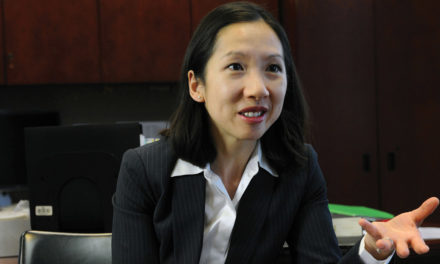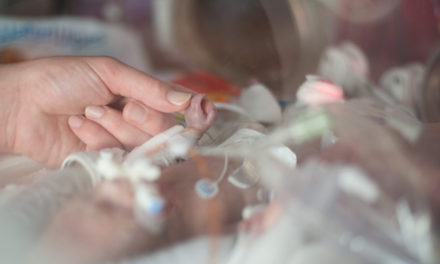If it hadn’t been for a committed group of bloggers, new media journalists, pro-life activists and Twitter users, the Kermit Gosnell trial very likely would not have made national news. When the trial of America’s biggest serial killer began in March 2013, it was treated almost entirely as a local story. And it would have remained that way if not for thousands upon thousands of Twitter and Facebook users and some savvy journalists in the new media world who embarrassed the old-line media into giving the trial the attention it deserved.
A few local news outlets and pro-life organizations had noted the raid on Gosnell’s clinic in 2010. Major newspapers and broadcasters including National Public Radio, ABC news and the BBC had published stories about the grand jury’s report and Gosnell’s indictment in 2011, but the coverage quickly died down. None of those stories made the front pages, and none of them prompted follow-ups. When media organizations want to cover a topic, very often they use an initial report of an arrest or incident as a jumping-off point. Journalists at their best ask questions and explore many different angles. They explore the history of the story, the cultural relevance of the story—they often look at minor characters the public might want to know more about. In short, they look at all the angles. But not on the Gosnell story.
The rare story that did appear included some sort of apologia from pro-abortion activists about how Gosnell’s indictment shouldn’t be taken as an indictment of abortion itself. Typically, newspapers went with wire copy. The Jan. 20, 2011 Associated Press dispatch by David Crary was headlined “Philly Abortion Murder Case Fuels National Debate.” But as journalist Mollie Hemingway pointed out, the supposedly objective AP story “begins and ends with quotes from abortion-rights activists and pro-choice framing overwhelms the piece.” And, Hemingway noted, Crary didn’t write another word about Gosnell until May 4, 2013. That story was headlined “Philly Abortion Murder Trial Has National Impact.” It read a lot like his story from two years earlier. AP did carry some trial news culled from local stringers, but its national reporter wasn’t assigned to cover the case.
Conservative new media and pro-life activists reported the Gosnell case from the very beginning, starting with the first police raid on the Women’s Medical Society Clinic in 2010. On Facebook, Twitter and in multiple blogs, the story of the notorious abortion doctor from Philly was reported regularly until January 2011, when the grand jury’s report exploded on the scene and Gosnell and his wife were arrested for murder.
Conservative Cadre
Along with Hemingway, J.D. Mullane, radio host and blogger Dana Loesch, satirist Iowahawk, writer Mark Steyn, Breitbart.com’s John Nolte, the National Catholic Register, the Catholic news site LifeNews.com, and blogger and conservative syndicated columnist Michelle Malkin were all over the story. They covered the grand jury report, the arrests and the trial. They explored the story from multiple angles, noting how the Pennsylvania Department of Health had failed to inspect Gosnell’s clinic for years. They called attention to other states’ abortion laws and pointed out how Gosnell could have gotten away with murder elsewhere, too. In short, they did the work reports in the national press should have been doing.
“I would love to critique the coverage of the trial of Kermit Gosnell, the abortion doctor whose mass murder trial is going on right now in Philadelphia,” Hemingway wrote at the Get Religion blog on April 8, 2013. “The only problem is that there is a curious lack of media coverage.” Apart from a short story The New York Times buried on page A17 on the trial’s first day, she didn’t have much to work with.
Until Hemingway and other conservative and Christian bloggers began pointing out the dearth of coverage in April 2013, the trial had received no attention on any of the network newscasts and, as the Washington Examiner’s David Freddoso pointed out, just seven mentions on cable news from the time it had begun on March 13—and six of those were on Fox News. (The other single mention was on CNN.)
Hemingway is a smart, tenacious reporter who made her name writing about the myriad ways mainstream U.S. journalists make a hash of religion. Now a senior editor at The Federalist, Hemingway was one of the new media up-and-comers who pushed the Gosnell trial into the national spotlight where it belonged.
“The fact that we were all talking about this shows this was something the mainstream media was not in touch with,” Hemingway told us. “We were waiting for this to be massive news, as we know from all other media coverage of serial murderers and abortion topics … Unlike stories about women who kill their boyfriends or whatever, where you get hourly updates on CNN, we were getting nothing.”
After the trial got underway, Twitter users by the thousands seized the opportunity to tag #Gosnell when they pointed out media hypocrisy in the coverage of mass shootings in Aurora, Colo., and Newtown, Conn., or any periodic media frenzy over some politician’s gaffe.
Some celebrities got involved, too. Actress Patricia Heaton, famous for her role as Ray Romano’s wife on the CBS sitcom Everybody Loves Raymond, was a prominent voice calling attention to the trial. On April 5, Heaton tweeted, “The news coming out of the Gosnell abortion clinic trial is absolutely horrifying, yet not one network has done any coverage of it. Not one.” Her complaint was retweeted 1,744 times. Heaton tweeted regularly during the trial, and her tweets got noticed.
Iowahawk tweeted, “What Romney did with a scissors in 1965: 20 acres of front page. What #Gosnell did with a scissors: crickets. #AirbrushingMassMurder.” Mitt Romney, for anyone who cares to remember, reportedly cut off a fellow student’s hair when he was a rambunctious lad at boarding school five decades ago. This earth-shattering news dominated an entire news cycle during the 2012 election campaign.
A look at Twitter between March 18-31 tells an interesting tale of how old media was dragged into covering the story by a tidal wave of social media.
Reluctant Participants
Only local media and a few pro-life activists tweeted on day one of the trial. One Twitter user with the memorable handle @ExPoleDancer wrote, “FYI—today was the first day of the trial of Philly abortionist/baby & woman killer Dr. Kermit #Gosnell. #philly #prolife.” On March 20, Erica Voll tweeted, “This #Gosnell case is astounding. Watching the stream is like getting punched in the gut over and over again.” On the opening day of testimony, blogger Pundette tweeted a link to a post in which she had urged her readers to “get over whatever prejudices are keeping them from getting on the right side of this issue, for the good of the victims of this ghastly culture, and for their own good as well.” Nationally syndicated columnist Mark Steyn picked up that post and commented on it at National Review Online.
Steyn, a conservative writer, had taken an early interest in the case and commented often. He compared the mainstream media’s tepid response to Gosnell with their coverage of the mass shooting at Sandy Hook Elementary School in Newtown, Conn., a few months earlier. “One solitary act of mass infanticide by a mentally ill loner calls into question the constitutional right to guns, but a sustained conveyor belt of infanticide by an entire cadre of cold-blooded killers apparently has no implications for the constitutional right to abortion,” Steyn wrote.
Other Twitter users picked up on the theme during the first week of the trial. “Hey @piersmorgan,” Ben Crystal wrote to now-former CNN chat-show host Piers Morgan. “So @TheDemocrats slandering the @NRA for #Newtown is news; but #gosnell the abortionist/butcher is not? #Journalism!”
“He kept severed feet in jars yet escaped mainstream media coverage #Gosnell trial continues,” tweeted a user called @IdaFlo. Linden deCarmo, a self-described Christian, software architect and “small government enthusiast” tweeted on March 21, “What ever happened 2 #ItBleedsItLeads? Do normal rules not apply when the accused supports 1 of the sacred cows of the left? #gosnell.” Twitter user @tricky223, a “poleclimbing Redneck who clings to his religion and guns while entertaining a fetish for the Constitution” tweeted to ABC, CBS and NBC News, “If the @NRA is responsible 4 Sandy Hook then isn’t #PlannedParenthood responsible 4 #Gosnell the Butcher of Philly?”
Pro-life activist Mary Mack replied to a snarky post-Newtown tweet by British comedian Ricky Gervais, who wondered, “Why don’t pro-life groups picket gun shops instead of hospitals?” “Because guns don’t kill people, #abortion docs kill people. That’s why. #Gosnell,” she wrote. (Gervais offered no response.)
On March 27, The Associated Press published a story about the trial in which reporter Maryclaire Dale described Gosnell as “an elegant man who appears serene in court” and who “smiled softly as he listened to testimony.” The Media Research Center’s Newsbusters.org Web site noted the AP dispatch was one of the few national news items to appear since the trial began—and it seemed to present Gosnell in an almost sympathetic light.
The pressure ratcheted up a little more on March 31, two weeks after the trial opened, when Wall Street Journal columnist Peggy Noonan tried to force the Gosnell trial into the national conversation on NBC’s Meet the Press. “The real story this week is the haunting and disturbing story of this doctor in Philadelphia, Gosnell, who is being tried this week,” Noonan said. “And if you wanted to watch the testimony, it was hard to find. But if you wanted to have a sense of what was happening, you could find it on the Internet or in the local papers.” The three major broadcast news networks had barely uttered a word about the case up to that point. And Noonan’s observation seemed to have no effect. There were no immediate follow-up stories, not even on NBC.
But alternative media was covering the trial closely. LifeNews, for example, was posting several stories a day throughout late March and early April, including several pieces calling out the national media’s blackout—not to mention politicians’ silence—on the story. Twitter users escalated their naming and shaming. Jeffrey D. Dickson, a conservative activist with more than 60,000 followers, tweeted on April 1, “Obama ‘weeps’ for the children of Newtown but is completely unmoved by the deaths of the abortion survivor babies of Kermit Gosnell.” “Dear @abc @nbc @cbs @cnn we shouldn’t have to rely on @PatriciaHeaton or the UK press to give us details on the Gosnell trial,” tweeted @KevininABQ on April 6. “Do your jobs.” Hundreds of similar tweets appeared over the same period, all echoing that message.
A group of pro-life activists including Bryan Kemper of Priests for Life, Jill Stanek and Steven Ertelt of LifeNews organized a tweetfest on April 12 from noon til midnight. Kemper, who was the motivator in chief for the tweetfest, wrote, “On your mark get set GO! Who is #Gosnell—Tweet till your fingers bleed!”
And finally, someone in the mainstream media noticed.
Changing the Conversation
Kirsten Powers is probably best known as a Fox News analyst and a columnist for the Daily Beast and USA Today, but she started out as a political operative for the Clinton-Gore presidential transition team in 1992 and spent five years in the administration as deputy assistant U.S. trade representative for public affairs. Although she was raised as an Episcopalian, she spent much of her adult life as an atheist. She became an evangelical Christian in her 30s, and she has called her conversion “a bit of a mindbender,” given her generally liberal politics and longtime aversion to religion. But she may be the only liberal newspaper columnist in America who is staunchly and outspokenly pro-life. It was Powers who gave the Gosnell trial the final push it needed into the national spotlight with her April 11, 2013 column in USA Today.
At the time, USA Today had the largest weekday circulation among all national newspapers with 2.88 million readers. The column was a scathing attack on her liberal colleagues in the mainstream media, and the subheadline on the piece was a seven-word indictment: “We’ve Forgotten What Belongs on Page One.”
In an interview with RealClearPolitics’ editor Carl Cannon, Powers explained how the Gosnell story had come to her attention. Her best friend from college, who coincidentally also had found religion later in life and was strongly pro-life, “kept bugging me about this Gosnell thing.” After her now-famous column appeared, Powers had to apologize to her friend because, she said, “even I had been on the phone with her, and she had been talking about it, and [I] had sort of been rolling my eyes, like, I’m sure.”
If something like this was going on, I would know about it, she thought.
Powers was cleaning out her email box and came across all the stories her friend had sent from pro-life Web sites and the local Philadelphia press. “I started reading them and just thought, ‘This can’t be true.’ … And I was so horrified by it. I just couldn’t believe it wasn’t being covered.”
She pitched the idea for a column to her editor, thinking he would say no. To her surprise, he said yes—she should write about it for later in the week. Then about an hour later she heard back from her editor, who said they’d want the article for the next day’s paper. “So I had to write it in two hours and I knew, obviously, not too much about it because … I hadn’t really been following it. It was a real scramble and a real high-wire act, getting it done.” The most influential column of her career, knocked out over a couple of hours.
Powers did a Lexis-Nexis search and learned that none of the major network news shows had mentioned the Gosnell trial in the previous three months. The exception was Noonan’s appearance on Meet the Press, where she “hijacked a segment … meant to foment outrage over an anti-abortion rights law in some backward red state.”
“You don’t have to oppose abortion rights to find late-term abortions abhorrent or to find the Gosnell trial eminently newsworthy,” Powers wrote. “This is not about being ‘pro-choice’ or ‘pro-life.’ It’s about basic human rights. The deafening silence of too much of the media, once a force for justice in America, is a disgrace.”
With this column in a major newspaper, the story of the media’s blackout of the Kermit Gosnell trial became a story too big to be ignored.
For More Information:
Gosnell: The Untold Story of Americaís Most Prolific Serial Killer (Regnery Publishing, January 2017) is available at http://amzn.to/2jQNXqb. Excerpted with permission.
Originally published in the April 2017 issue of Citizen magazine.






